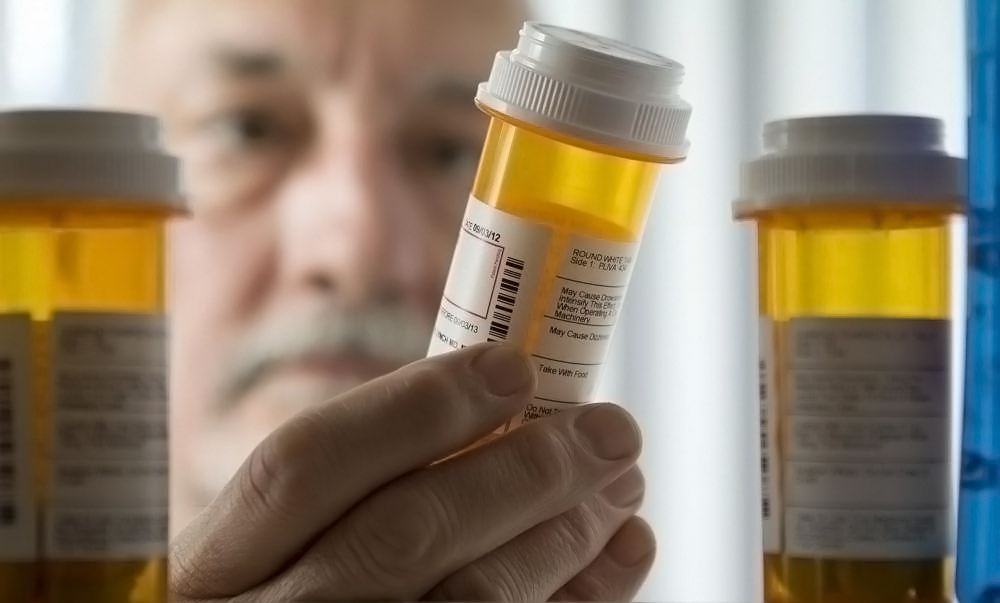What is Oxycodone?
Oxycodone is a narcotic medication belonging to the class of drugs known as opioids that are used to treat moderate to severe pain. Oxycodone or “oxy” as it’s commonly referred to is taken orally and is used under several different brand names including Oxyado, Roxicodone, Roxybond and OxyContin. The drug comes in five forms: immediate-release tablet, extended-release tablet, immediate-release capsule, extended-release capsule and solutions. It is considered a controlled substance by the Food and Drug Administration (FDA) in the United States, meaning it can only be used through a prescription acquired from a healthcare professional through channels like pharmacy prescriptions.
Oxycodone works by attaching to receptors throughout the body, including in the brain, spinal cord and gastrointestinal tract. Once it has become attached to the receptors, it blocks the transmission of pain signals to these areas of the body, thus providing relief. Dosages of the medication are dependent on the patient and what it is being used in response to.
The use of oxycodone through prescription pills like OxyContin is on the rise in North America and has unquestionably been a factor in the opioid epidemic that has been so prevalent in recent years. Of course, when used in consultation with a doctor or physician oxycodone can provide much-needed relief from pain and discomfort. However, as with other opioids, oxycodone is a highly addictive narcotic substance and many people who first start using the medication for legitimate reasons may become dependent or addicted to it. Not only do addiction and misuse carry plenty of dangerous potential along with them including short and long-term health concerns, but because opioids are only available through prescription, an addiction can lead to engaging in dangerous activities such as purchasing the medication through a drug dealer or other risky sources. Not only is this dangerous in and of itself, but when oxycodone comes from an unknown source, there’s a real possibility it may be laced with fentanyl or other substances that could be fatal.
For a glimpse into the scale of opioid use in North America, United States drug companies distributed over 76 billion oxycodone and hydrocodone (a slightly less potent painkiller) pills throughout the country between 2006-2012 alone, according to the Washington Post. This exorbitant number of pills distributed helped fuel the opioid epidemic, which resulted in almost 100,000 deaths during that same time period alone. Of course, the epidemic isn’t unique to the United States, as it has been prevalent in many nations across the globe.
One of the reasons oxycodone use has become so common is that its different iterations are prescribed to treat a large number of different ailments. A general breakdown of the different use cases is as follows:
- Extended-release tablets and capsules – Used for relief of severe pain for individuals that require round-the-click medication in order to mitigate the pain issues they’re experiencing.
- Immediate-release tablets and capsules – Used for relief of acute or “breakthrough” pain that comes on quickly. It begins to relieve pain in around 15-30 minutes and will continue to work for 3-6 hours.
Oxycodone can also be used as part of a treatment method called “combination therapy,” which means it’s used in conjunction with other forms of medication to produce a specific desired effect. One example of this would be when oxycodone is combined with acetaminophen to form Percocet. Because there are so many different uses for oxycodone and its various forms, and because those medications can be so valuable in reducing discomfort and pain, oxycodone addiction becomes a real possibility for many regular users. And, since the drug is legitimately required in many cases for prolonged periods of time, it can often be difficult to assess when regular use has transitioned into oxycodone use disorder, another term for addiction. It’s essential that individuals using oxycodone learn how to identify the addiction symptoms so that they can put together a plan to counter the addiction if it occurs so that they may eventually resume leading a healthy life.
Addiction Symptoms
Overuse of oxycodone leads to forming a tolerance and dependence on the medication, which can lead to serious addiction issues. The first and most obvious sign of addiction is when individuals use the medication outside of the way it was prescribed by their healthcare professional. This may mean simply taking an excessive number of pills as compared to what’s been instructed, but it can also describe oxycodone users that go “doctor shopping” to acquire multiple prescriptions or attain the medication through a drug dealer or other illicit channels. This can also apply to simply continuing to take the drug once the pain subsisted.
As with other forms of opiates like heroin, additional signs of addiction may be obvious in the form of financial difficulties or run-ins with the law as a result of drug usage. Because pills like OxyContin are only available through prescription (and in some countries, not at all), acquiring the medication through illegal channels is often an extremely expensive endeavour on top of being a dangerous one.
Socially, oxycodone use disorder can result in isolation as the priorities in your life shift to reflect dependencies on the medication. Building on that, addiction and misuse can also result in alienation from friends, family and loved ones as it’s not uncommon behaviour in individuals addicted to drugs to continue using them despite negative reactions from those close to them. In line with these symptoms, performance in athletics, academics and work may greatly suffer.
In addition to the risky behaviour required to attain oxycodone through a drug dealer or on the black market, addicts may exhibit other dangerous or risky behaviour that puts others in harm’s way. This could mean things like mixing oxycodone with alcohol or hard drugs and then operating a motor vehicle. Not only does this put the individual that’s addicted to the substance at risk, but rather any ordinary people in society that may take to the road or walk down a sidewalk on a given day.
It’s possible that oxycodone addicts may not know that they are addicted to the substance. One surefire way to determine if a dependency has been created is to watch out for withdrawal symptoms when an oxycodone user has gone without the substance for a short period of time. The withdrawal symptoms vary from person to person but are often more obvious in cases of severe or prolonged addiction.
Withdrawal Symptoms
Whether individuals are purposefully trying to quit oxycodone-based medications like OxyContin, or the elimination of the substance has been caused by a lack of a continued supply or other factors, withdrawal symptoms are likely to appear when regular oxycodone users stop using the medication. The symptoms of withdrawal range in severity and are determined by things like medical history and condition of users, length and severity of the addiction and other factors.
Common withdrawal symptoms for oxycodone addicts include nausea, tremors, tics, shakiness, runny nose, profuse sweating, abdominal cramps, muscle spasms, loss of appetite, intense drug cravings, insomnia and diarrhea. While many of these symptoms are undoubtedly uncomfortable and even painful in some cases, they are not generally considered life-threatening. Withdrawal symptoms are best treated under the guidance of a healthcare professional. Whether in an inpatient facility or simply with the direction of an addiction specialist-provided recovery plan, some of the withdrawal symptoms may be made less uncomfortable through preventative measures.
While encountering withdrawal symptoms, it’s important that individuals don’t deviate from the advice of their healthcare professional or addiction specialist. However, in most cases, doing regular activities that encourage healthiness can be a positive strategy to counter the effects of withdrawal. Some examples of this include drinking a lot of water and/or liquids, eating regular nutritious meals, using deep-breathing and stretching exercises, practicing relaxation techniques, distracting oneself and using positive self-talk.
Contacting a healthcare or addiction professional to help chart out a recovery and treatment plan is always an advisable first step. As noted, doing so may be an important factor in mitigating or even eliminating some of the withdrawal symptoms. Furthermore, it can be a really important step in the long-term recovery process and can help oxycodone addicts develop a blueprint for the prevention of relapse or continued use. Every person is different, so tailoring a specific rehab plan to each individual based on their medical history and condition, and a plethora of other factors is always practical.
Treatment Options
Once someone has determined they have an oxycodone addiction, seeking treatment can help lead them to recovery and the resumption of regular, healthy lives. As mentioned previously, a consultation with a healthcare professional or addiction specialist is a logical first step in charting out a treatment plan that makes sense based on the individual.
Rehab and detox treatments based in inpatient facilities under the supervision of an addiction specialist are methods used to treat oxycodone addiction. This can be effective for oxycodone addictions ranging from moderate to severe and offer a structured, controlled environment that is valuable in the early stages of recovery. Additionally, installing patients in safe settings such as detox centers may eliminate many of the stresses and triggers that can lead to relapse in the outside world. Another benefit of recovery centres is that they often provide many psychological treatments aimed at curbing the root causes of oxycodone addiction. These activities may include cognitive behaviour therapy sessions, individual therapy, family and group therapy, holistic therapy and motivational enhancement therapy. These types of facilities often offer 30-, 60- and 90-day programs.
In less severe cases of oxycodone addiction, it’s possible that patients may simply undergo some of these treatment methods on their own accord and outside of an inpatient facility. On top of these strategies, other forms of treatment may include recreational and nutritional programs, peer-support systems and other approaches that make sense based on the individual.
If unsure about treatment options, there are a multitude of resources available to individuals impacted by oxycodone addiction. In the United States, the Substance Abuse and Mental Health Services Administration (SAMHSA) provides a 24/7, 365 helplines that can be reached at 1-800-662-4357 (HELP). In Canada, addiction helplines are available in each province and can be found on the Government of Canada website. All of these helplines are excellent sources of information for locating nearby healthcare specialists, drug counsellors, treatment and recovery options, or just as a place that individuals facing addiction can turn to if they’d like someone to talk to about the issues they are encountering. People tackling addiction issues and those close to them can often feel helpless, but it’s valuable to remember that change is possible and given the right addiction plan and support system, resuming a normal, healthy lifestyle is possible.







